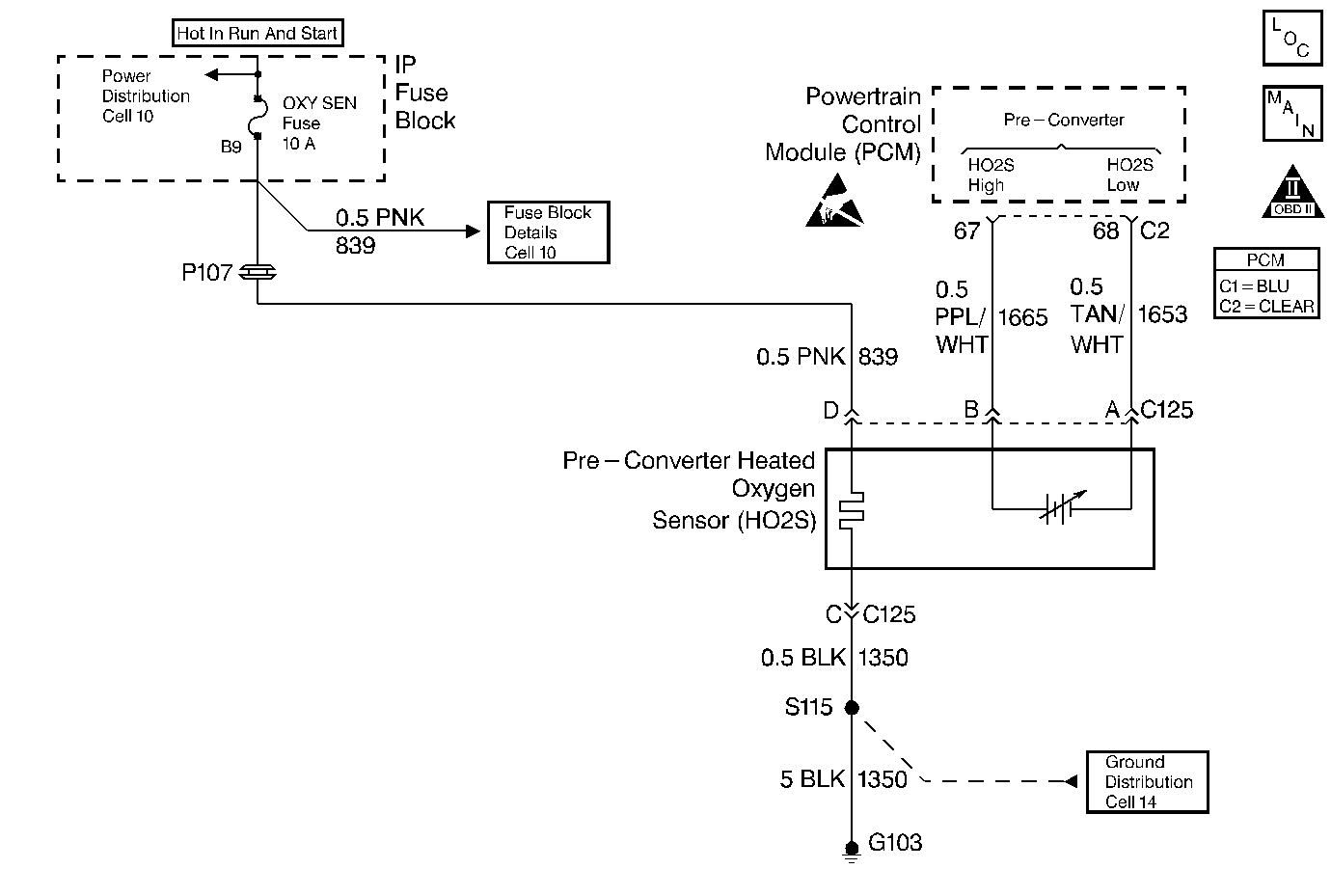
Circuit Description
The PCM provides a 0.45 volt reference signal to the oxygen sensor on CKT 1665. When the oxygen sensor is cold, below 200°C (392°F), the oxygen sensor signal voltage will be around 0.45 volt and the PCM will keep the system in Open Loop operation. When the oxygen sensor is warm, above 200°C (392°F), the oxygen sensor will swing from rich to lean rapidly, if the PCM is in good control of the air fuel mixture. DTC P1139 is designed so that if the oxygen sensor is slow to respond to changes in exhaust oxygen content, then DTC P1139 will set.
Conditions for Setting the DTC
Test Conditions
| • | DTCs P0117, P0118, P0121, P0122, P0123, P0131, P0132, P0133, P0134, P0135, P0141, P0151, P0152, P0153, P0154, P0155, P0300, P1133, P1134, P1153 and P1154 not set. |
| • | This test has not been completed yet this ignition cycle. |
| • | Low coolant level not present. |
Failure Conditions
| • | Number of rich to lean transitions less than 20 in 120 seconds. |
| • | Number of lean to rich transitions less than 20 in 120 seconds. |
Action Taken When the DTC Sets
| • | The PCM will illuminate the malfunction indicator lamp (MIL) when the diagnostic runs and fails. |
| • | The PCM will record operating conditions at the time the diagnostic fails. This information will be stored in the Freeze Frame and Failure Records. |
Conditions for Clearing the MIL/DTC
| • | The PCM will turn the MIL OFF after three consecutive drive trips that the diagnostic runs and does not fail. |
| • | A Last Test Failed (current) DTC will clear when the diagnostic runs and does not fail. |
| • | A History DTC will clear after forty consecutive warm-up cycles with no failures of any emission related diagnostic test. |
| • | Use a scan tool to clear DTCs. |
| • | Interrupting PCM battery voltage may or may not clear DTCs. This practice is not recommended. Refer to Clearing Diagnostic Trouble Codes in PCM Description and Operation. |
Diagnostic Aids
Notice: Do not solder heated oxygen sensor wires. Soldering the wires will result in the loss of the air reference to the sensor. Refer to Engine Electrical for proper wire and connection repair techniques.
If fault is not present perform Powertrain Ground Check and also review Failure Rec. to determine conditions under which and how long ago the DTC set.
Test Description
Number(s) below refer to the step number(s) on the Diagnostic Table.
-
Checking if other possible causes of this DTC have already been diagnosed.
-
Diagnose other DTCs first because they may be the cause of this DTC setting.
-
With the engine running warm, coolant at least 85°C (185°F) and at fast idle, the oxygen sensor voltage should rapidly swing above 0.60 volt and below 0.30 volt.
-
Checking if the oxygen sensor voltage is swinging between rich and lean very slowly, or not at all.
-
Checking for causes or oxygen sensor failure. If sensor is replaced without finding cause of contamination, contamination of new sensor may result.
Step | Action | Value(s) | Yes | No | ||||||
|---|---|---|---|---|---|---|---|---|---|---|
1 | Was the Powertrain On-Board Diagnostic (OBD) System Check performed? | -- | Go to A Powertrain On Board Diagnostic (OBD) System Check | |||||||
Were you sent here from another DTC? | -- | |||||||||
Are any other PCM DTCs set? | -- | Diagnose other PCM DTCs first | ||||||||
After the two minutes does the Pre-Converter oxygen sensor voltage rapidly swing above and below the range specified? | 85°C (185°F) 1200 - 2000 RPM 0.30 - 0.60 volts | |||||||||
5 | With engine running at 1200 to 2000 RPM, view the scan tool display Loop Status. Does the display indicate Closed? | -- | Fault not present Refer to Diagnostic Aids | |||||||
Does the Pre-Converter oxygen sensor voltage remain between the range specified longer than it swings outside this range? | 0.30 - 0.60 volts | |||||||||
7 |
Was terminal contact repaired? | -- | Go to Powertrain Control Module Diagnosis for Verify Repair | |||||||
8 |
Is terminal contact OK? | -- | Go to Powertrain Control Module Diagnosis for Verify Repair | |||||||
Were any of these possible cause found? | -- | Take necessary corrective action | Refer to Fuel System Check |
